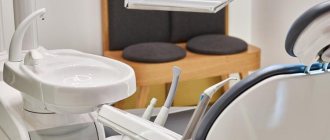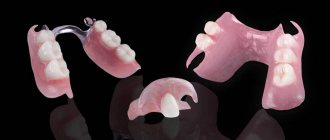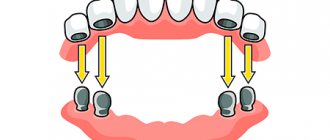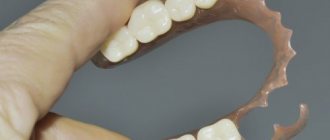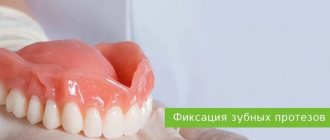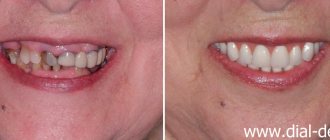Artificial jaws: types
First of all, let's define the terminology to make the following text easier to understand.
- Basis - the base, which looks very similar to the gum, fits tightly to the oral cavity. The borders are made of modern polymer materials.
- Fastening – various locks with hooks securing the entire structure to supporting healthy organs.
- Implants are elements firmly embedded in the base, replacing individual chewing units. In production, light components are used that are as close in color to real teeth as possible.
Classification by type
Types are divided according to the substances contained in the composition. However, a distinction based on how partial dentures are placed, how they are inserted and secured, and what the dentures look like is the most correct approach.
Lamellar
The most inexpensive and accessible way to restore chewing functions. The plastic base completely covers the curves in the patient’s mouth and the contours of the gums. They are attached to supporting intact masticatory organs. Acrylic, nylon, and other modern materials that prevent allergic reactions are used in the production of these implants.
Low cost with simple fixation are the main advantages. The age group of patients for their use is not limited. However, the restoration of chewing functions does not occur completely; diction may be impaired, and the structure does not hold well in the mouth. The photo shows the installation of removable plate and one-sided dentures on hooks.
Clasp
Artificial analogues are attached to a metal frame. Since the base is made of durable material, the product will last quite a long time. Installed using various hooks, crowns and other methods.
This type of substitution is not suitable for those who have allergic reactions to the main component. High cost is also a significant disadvantage. Among the positive features are strength, strong fixation, complete restoration, natural appearance.
Immediates
They cannot be considered a permanent solution, as they are temporary measures. The installation of partially removable dentures is shown in the photo.
For a short period of time they can completely restore all aesthetic and chewing functions. But, it should be remembered that their use is only possible when one or two damaged units are restored.
Low cost along with quick installation are positive aspects. Soft components make the implant unstable to heavy loads and greatly reduce its service life. The use of immediates is common in dental practice when it is necessary to prevent the displacement of remaining teeth towards the removed ones.
Method number 1: on the gums and palate
The most common and budget option is overdentures, which are held in the mouth using the suction effect on the mucous membrane, palate and gums. These are completely removable structures that are installed when there are no teeth at all. They are very massive, have a palatal overlap in the upper jaw and a large base if it is necessary to restore teeth in the lower jaw.
The bulky base of such devices helps to increase the area of contact with the mucous membrane, because without this they simply will not be able to stay in the oral cavity. However, the base of the structures also becomes the main reason why patients experience discomfort. The base covers the gums, rubs them, causes attacks of nausea and increased salivation, interferes with full conversation and the taste of your favorite dishes, and small pieces of food get stuck under it.
Such dentures are fixed on the gums and palate
There is a large selection of similar structures: acrylic, nylon, silicone, from monomer-free materials of Italian quality (Quattro Ti) and acrylic resins (Acry-Free). Each type of device has its own advantages, but they are all united by a big drawback, which is most clearly manifested in patients who choose covering dentures in the absence of teeth. Bone tissue atrophy occurs under the structures, which is why they gradually begin to fit poorly to the gums and fall out of the mouth without the use of glue or additional corrections by an orthopedic dentist.
How to make a denture, a completely artificial false jaw: materials
The components that form the basis of such products determine the quality of human life. Good and durable, anti-allergenic, do not cause discomfort, are installed painlessly, quickly and easily. The main thing is that there is no rejection.
Prostheses from the low price segment are often manufactured in a short time. However, they do not tolerate heavy loads well, do not last long, and can cause unpleasant sensations: itching, irritation of the oral cavity.
Plastic
Affordable and widespread chemical material. It is used in all spheres of human life: from domestic needs to medical. It gained popularity due to its efficiency and easy processing.
Low cost greatly influenced its development in dentistry. The affordable price is perhaps its only advantage in this area. Simple installation, fastening of partially removable and fully overlay plate dentures with the palate has the following reviews:
- fall out;
- ugly appearance;
- cause severe discomfort while eating due to unevenly distributed load.
Particularly weak attachment in the lower jaw area. The sublingual space is uneven, so it is impossible to attach a classic suction cup to it. The problem is solved as follows:
- use special creams for retention;
- installation of the lower chewing part is carried out on living units.
Orthopedic products are held in place by clasps, which grip the implant at the base and give the structure the necessary rigidity. The most popular are removable dentures ivocap with the following pros and cons.
Positive traits:
- the upper jaw has good stability;
- low cost;
- common;
- suitable for repair;
- ease of construction;
- unpretentious in care.
Negative sides:
- a large frame takes up a lot of space in the mouth;
- clasps are noticeable with close eye contact;
- the lower part is poorly fixed;
- the alveolar arch and process gradually atrophy;
- short-lived.
Recommended as a temporary solution, or for complete/partial edentia.
Made from acrylic
The most inexpensive and widespread prostheses, which are based on polymer masses of low cost and quality. Among all lamellar ones, they are able to provide acceptable aesthetics. They are highly allergenic, fall out, break and cause discomfort.
Acry-free
Removable dentures or dentures made from an improved polymer relieve its owner from possible irritation of the oral cavity, are more durable, and reduce the risk of breakage.
An excellent option for temporary solutions while a high-quality and durable replacement is manufactured. People with hypersensitivity can easily wear them until full implants are inserted.
Spofadent
The base is made of three-layer plastic. They are characterized by durability, strength, resistance to chemical compounds, and visual appeal.
The design is loved by dentists and clients for its beautiful appearance. A colored complete removable denture is an analogue of living tissue.
IvoBase
Polymethyl methacrylate is an organic plastic that has innovative properties thanks to a unique creation method (the polymer is mixed in an injection device):
- greatly reduces the risk of an allergic reaction;
- prevents hypersensitivity;
- eliminates errors (low bite, large shrinkage).
Automation follows the entire technological process exactly. As a result, porosity decreases and strength increases. These properties ensure the durability of the entire system.
Vertext
Modern and thermoplastic, eliminates the use of monomer. Dryness, burning, allergic reactions are completely absent. The material is much stronger than analogues. Consequently, the basis is very thin. In turn, it increases the sensitivity of taste buds and articulation.
DeFlex
An Argentine company has made a breakthrough in dentistry by developing a polyamide that ensures complete transparency of the entire frame, including clasps. Transmitting light, it completely merges with the tissues of the oral cavity.
Widely used by athletes, police officers, and emergency services to provide jaw protection.
Nylon
The base is filled with soft nylon. 100% transparency ensures complete fusion with the mucous membrane. Clasps are made of the same material.
The patient quickly gets used to the foreign body in the mouth. High elasticity reduces stress on gums and soft tissues. The sufficient strength of the material used makes it possible to minimize the frame in order to maintain diction.
However, the pros turn out to be cons. To answer the described contradiction, it is important to understand the following question: how is a full-fledged nylon denture installed?
The thin and elastic component located at the base requires a mesh structure. When chewing hard food, fibers dig into the palate or gums, causing pain.
Advantages:
- quick addiction;
- 100% camouflage;
- biocompatibility.
Flaws:
- frequent hair loss requires you to always use fixing creams and ointments;
- chewing function – weak;
- expensive;
- lead to accumulation of plaque on the rough part;
- require adherence to a strict diet;
- the alveolar ridge bears the entire load.
Indications for use:
- partial edentia with preservation of supporting organs;
- in cases where aesthetics comes to the fore;
- The patient is allergic to acrylic.
So, we figured out how false jaws are made, the pros and cons of dental prostheses and various components. Let's move on to indications for the use of other types.
Let's look at the most common reasons for poor fixation of a complete removable denture.
- Most often, the reason is poor fit of the prosthesis to the gum (prosthetic bed). This may be a consequence of poor quality (accurate) manufacturing, or prolonged use of the prosthesis. In this case, a gap appears between the prosthesis and the gum, air gets in there and the prosthesis “falls off.”
- The second reason for poor fixation of a removable denture is severe atrophy of the jaw bone tissue. With significant atrophy, the relief of the bone tissue becomes almost flat, which in itself makes it difficult to fix the prosthesis (it has “nothing to catch on” with a flat prosthetic bed). In addition, with bone atrophy, the muscles of the oral cavity are located closer to the prosthesis and during work (smiling, chewing or talking) contribute to “throwing off the prosthesis.”
Photo 3.1. Poor conditions for fixing a removable denture: severe atrophy of the jaw ridge, high attachment of the lip muscles.
What can I do to ensure that my removable denture stays in place well?
Method No. 1:
The easiest option is to purchase a special cream for fixing dentures. TV often shows commercials for various gels for fixing dentures, which instantly make their owners happy. Such “glue,” of course, can improve fixation to a certain extent, but according to patient reviews, this method has a number of disadvantages. For example, sticking of “glue” residues to the gums after removing the prosthesis, complicating the cleaning of the prosthesis, which must be done every day in the morning and evening. Well, and most importantly, such a cream does not guarantee a 100% result (although it is much better than nothing).
Today there is a wide variety of dental creams for fixing dentures: Corega, Protefix, Lacalut Dent, Fittident, President, Dentipur, ROCS
In any case, if you use such a cream/gel, you should follow certain recommendations:
Rules for using creams and gels for fixing dentures:
- Apply the cream only to a dry and clean surface of the prosthesis
- the amount of cream should be small, otherwise you can achieve the opposite effect and worsen the fixation
- the denture is pressed tightly against the gum for 15-20 seconds
- After fixing the prosthesis, you need to refrain from eating and talking for 20 minutes
- do not use the cream more than once a day
- After removing the prosthesis, thoroughly clean the prosthesis from any remaining cream.
Method number 2:
If the cause of weak fixation is poor fit of the prosthesis, but the service life of the prosthesis has not been exhausted, the artificial teeth have not been worn out and satisfy functional and aesthetic requirements, then it is possible to “reanimate” it. The doctor’s task is to make sure that the prosthesis fits very tightly to the gum and suctions well. This will require a procedure called denture relining . The essence of relining is to close the gap between the prosthesis and the gum with special plastic, which is layered onto the prosthesis from the inside. Relining can be “clinical”, when the doctor adds plastic to the prosthesis in one visit directly in the dental chair, and “laboratory”. When carrying out laboratory relining, the orthopedic doctor takes an impression along with the prosthesis and transfers it to the dental laboratory, where the dental technician “refines” the prosthesis. After these manipulations, the prosthesis begins to perfectly fit the prosthetic bed and “holds” much better.
Method number 3:
In case of bone tissue atrophy, simple relining of a removable denture is not enough. To improve the fixation of a removable denture, additional supporting and retaining elements are required - dental implants.
Besides, we (the patient and the doctor) want more! I would like the prosthesis to hold even better, and to be smaller in size. Is it possible?
Yes! Maybe! And this will not require any extra effort or global financial investments.
Immediate
Replace a unilateral included defect. The design can be created from any materials used in dentistry. Capable of restoring a row of holes. Also found under the name "butterflies".
Several artificial crowns are attached to a miniature base, secured with hooks and locks. Recommended as a temporary solution after removal of diseased masticatory organs.
For those who are going to install metal ceramics and do not have enough money, it helps to gain time to collect them. Some patients use it all their lives, replacing it with a new one after a few years.
What to do if the denture rubs the gums?
If the prosthesis begins to rub the gums, pain and discomfort begin, you need to evaluate how intense this pain reaction is.
If these are minor pain sensations: it hurts a little, aches a little, tingles, then you can wait 2-3 days, using pharmacy ointments for pain.
If these sensations do not go away within 2-3 days, or the pain intensifies, then you need to go to the doctor who made this removable denture. The doctor will look at your jaw and in those places where the prosthesis presses too much, he will adjust it and sharpen it so that in this place the prosthesis does not press through the mucous membrane. There may be one or several such corrections, depending on the sensitivity of the patient’s mucosa. Over time, these corrections stretch from one to two to three weeks.
Conditionally removable
Anyone who has ever gone to the dentist for dentures is concerned about how to make them, who makes and inserts dentures on hooks, what methods of fastening exist, and what they look like on the teeth.
The design received its name due to special fixation methods. Special crowns and clasps ensure a secure fit in the mouth. They will never fly out on their own. You can remove it using special skills (usually a dentist does this).
Clasp
This type of implant is described above. Additionally, 3 types of structures should be distinguished:
- Clammers. The metal claw mount provides a secure fit and poor aesthetics.
- Lock. Divided into two parts: the first on the side, the second on the inside. Installation of such a connection requires grinding of adjacent elements.
- Telescopic. The inner crown is made of solid metal, onto which an outer structure (for example, ceramic) is placed.
Indications for use:
- edentia, in which at least 5 teeth are preserved;
- more than three units in a row are missing;
- mobile teeth (loose);
- other implants cannot be installed.
Quadrotti
Clasp or clasp without metal. Biocompatible plastic is at the core of the entire design.
Positive traits:
- there is no need to grind the supporting parts;
- the material does not cause allergies;
- cheap;
- the patient gets used to it easily;
- the chewing load is distributed correctly.
Negative qualities:
- despite greater stability compared to fully removable ones, the fixation is weak;
- the classic arc has high strength;
- service life is 3-4 years.
How a new generation of complete removable dentures are attached without a palate and what they are like
It is based on two materials:
- hard acrylic for bases and implants;
- soft polyurethane for fasteners.
At the base of the mechanism is an imitation of gum, which ensures a strong fixation. Dentists are still arguing about what type they should be: completely removable or not.
Comments
What materials are such a prosthesis made of?
Makarova O.A. (08/21/2020 at 10:17 pm) Reply to comment
- The artificial base and gingival edge of the prosthesis are usually made of acrylic, but they are also made of nylon, silicone, polyurethane, and non-monomer acrylic resins. Fastening elements can be made from the base material that makes up the base of the prosthesis, but for strength and greater wear resistance they are often made from medical metal alloys. As for artificial teeth, they are made of plastic, metal-plastic, ceramic and metal-ceramic, and zirconium dioxide. That is, the choice is very wide and actually depends primarily on the type of prosthesis you choose (removable or implant-supported).
Editorial staff of the portal UltraSmile.ru (08/23/2020 at 12:21 pm) Reply to comment
Thanks for such a wonderful article. Tell me, what do you think, with very problematic and regularly inflamed gums, which option should you pay attention to first? The area for prosthetics is large, but I don’t want removable dentures.
Marina A. (09.23.2020 at 09:18) Reply to comment
Please tell me, my mother wants to install such a prosthesis, but I have heard that they are not reliable, they can fly out and wobble. In this case, there will be severe discomfort, is that true?
Elena (09/23/2020 at 01:01 pm) Reply to comment
And I heard that fixing dentures with cream, firstly, is not very reliable, and secondly, with prolonged use it can be dangerous. What creams should I use to ensure safety?
Victor (09/23/2020 at 01:07 pm) Reply to comment
If a removable denture was installed not so long ago, you are wondering how it is fixed, what is the covering structure? How much will it cost to fix removable covering systems on implants?
Oleg (09.23.2020 at 14:30) Reply to comment
Dentures were placed on the upper jaw. It took me a long time to get used to it, they pressed and rubbed. The gums were inflamed. I went many times for correction. Probably in a couple of months I began to wear them fully, but they began to fall off while eating. My dentist recommended Mostaden Twins Tech cream to me. It easily attaches to wet dentures. Does not change the taste of food and drinks. There is a pleasant mint taste in the mouth. Has a secure hold for up to 12 hours. Prevents food from penetrating under the denture. I began to fully wear the prosthesis without fear that it would fall out while eating or while talking.
Alice (10/21/2020 at 11:34 am) Reply to comment
Good afternoon Can you please tell me how long it will take to install dentures on my natural teeth? Is there any alternative while the prosthesis is being manufactured? Thanks in advance for your answer.
Sasha (11/20/2020 at 6:29 pm) Reply to comment
Of course, you can fix any prosthesis in your mouth. Both the lower and upper parts. But if you had surgery or had a bone cut off, then the prosthesis may not fit on such gums. Not every specialist will undertake such work.
Alina (11/20/2020 at 08:22 pm) Reply to comment
It’s good that now there are so many ways and options. But which one is the most reliable, which is recommended in most cases? Or will it all be purely individual?
Olga (11/20/2020 at 08:29 pm) Reply to comment
After reading the article, several questions arose. 1) How long do removable and fixed implants last? Which ones are more durable? 2) Is it difficult to care for them and maintain an aesthetic appearance?
Artyom (11/20/2020 at 09:04 pm) Reply to comment
Of course, implants are better because they will last better. And so my mother used Corega cream. Helped a little, but not much. She has the most ordinary prosthetics. Although I already made the second one 15 years later. The gums sank, so the first ones no longer held up.
Peter (11/20/2020 at 9:16 pm) Reply to comment
Write your comment Cancel reply
What to choose if you are completely missing teeth
If the doctor has not identified any contraindications, separate implants are recommended. However, you can look towards removable or partially removable options.
Partial absence
Conducive to installing butterflies and crowns. Any of the methods described in the article is suitable for replacing a bite. Only a qualified specialist can provide the correct advice in each specific case.
For the upper and lower parts of the mouth
If we are talking about removable structures, plate options can be used at the top, and fixed ones at the bottom. This advice is based on the anatomical features of the jaw. However, only the doctor will provide the correct solution.
Indications for prosthetics
The main indications for dental restoration are a significant deterioration in the quality of chewing food, diseases of the gastrointestinal tract, and traumatic tooth extraction as a result of an incident or accident. The aesthetic factor is also extremely important.
If tooth loss as a result of injury cannot be accurately predicted, then the appearance of certain symptoms should be the reason for an emergency visit to the dental clinic. Gum diseases, caries, tooth decay, chipped enamel from their front surface - all this requires immediate intervention from a dentist. Most dental diseases lead not only to oral discomfort, but also to tooth loss.
Service life and care
Durability depends on materials, quality of installation and maintenance. The following tips will help you make it last as long as possible:
- every 6 months it is necessary to visit a doctor to assess the condition - especially when using rigid structures;
- 2 times a day you need to treat the oral cavity and removable jaws with a solution or rinse with clean water;
- follow individual recommendations received from your doctor.
The article answered the questions: what is a complete and partially removable denture, what types are there in dentistry, which are better, what the price depends on. It should be noted that the text is not a guide to action; its main purpose is to introduce the reader to the varieties. If you have any questions or pain, please contact your dentist.
Cover structures – what are they?
In the classical sense, overdentures are removable appliances that get their name from the word “overdenture,” which literally means “overdenture” in English. That is, they usually cover, or more precisely, rest on the teeth and roots preserved in the mouth, or installed implants. In this case, the term “covering” is considered most appropriate.
Overdentures are removable appliances
However, today this is the name given to any removable systems. Even those that rest solely on the gums, when there are no teeth at all in the mouth. Experts justify this by the fact that in this case the structures are also covered, only not by implants and teeth, but by gums.
A dental overdenture can fill just one defect, can be partial (for partial and multiple edentia) or complete, when it is necessary to restore all the teeth on one/several jaws.
Now let’s look in more detail at what methods of fixing covering systems in the oral cavity exist.


